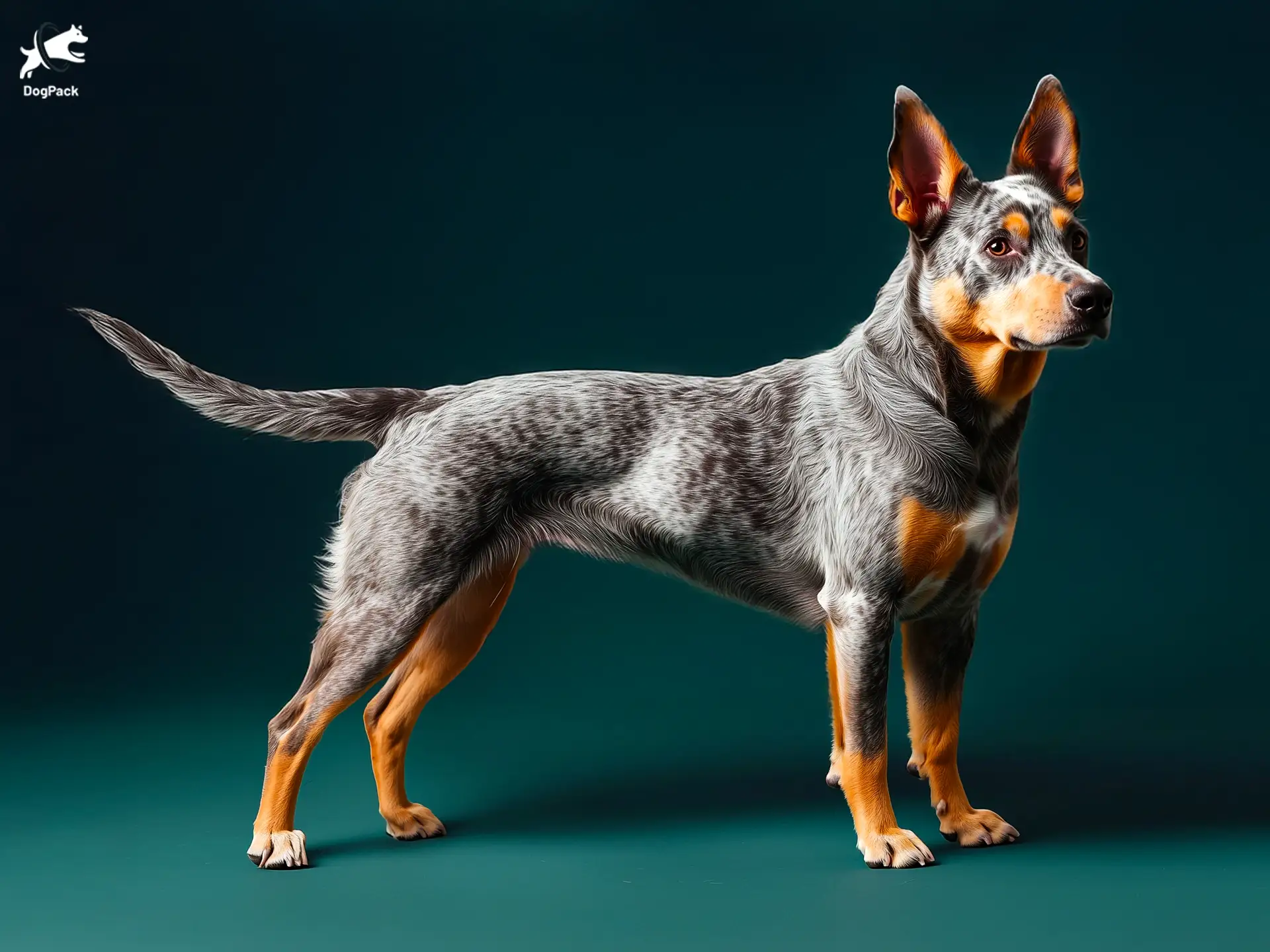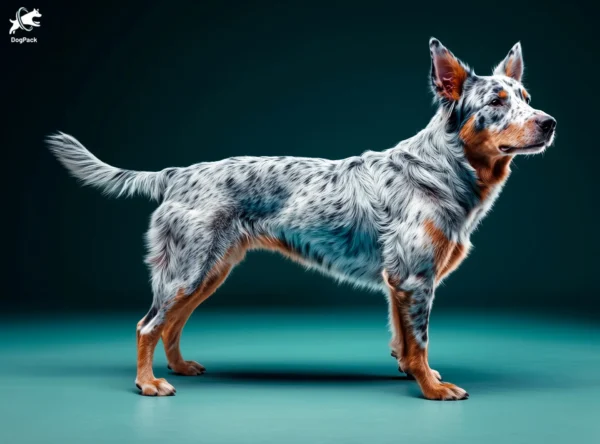Texas Heeler Dog Breed Info & Overview
The Texas Heeler is a high-energy herding dog that excels in both work and companionship. A mix of the Australian Cattle Dog and Australian Shepherd, this intelligent hybrid is known for its loyalty, agility, and problem-solving skills. Ideal for active owners, the Texas Heeler thrives on mental stimulation and exercise, making it a perfect match for those who love outdoor adventures.
Characteristics
Pictures
Breed History
Though not as ancient as some dog breeds, the Texas Heeler has roots tracing back to 1970s America, when ranchers sought a reliable herder to manage livestock. By crossing the sharp-minded Australian Cattle Dog with the ever-versatile Australian Shepherd, they created a hardworking and agile partner. This blend quickly found favor among farmers who prized stamina and intelligence.
Historically, these dogs excelled in rounding up cattle, sheep, and even stubborn goats. Their unwavering focus and quick reflexes made them invaluable on expansive ranches. Selective breeding over time refined their innate herding instincts and robust physique. Many families recognized their talent and welcomed them into households for both practical work and devoted companionship.
The Texas Heeler’s name famously honors the Lone Star State where many early crossings took place. Over the decades, these resilient canines evolved into dependable ranch hands with a dash of Aussie charm. While they may not carry the storied lineage of older herding breeds, their impressive track record proves that sometimes modern innovation can rival tradition.
Temperament, Personality
Lively and alert, these dogs rarely miss a beat. Their keen observation skills make them quick to respond to changes in their environment. They’re known to form tight bonds with their favorite humans, often following them from room to room. Thanks to their herding background, they may sometimes “herd” family members, so gentle guidance is a must.
Though typically good-natured, they can be a bit reserved with unfamiliar faces until they’ve assessed the situation. Early socialization helps channel their natural protectiveness into confident, friendly behavior. Energetic and eager, they benefit from daily mental challenges, such as puzzle toys or learning new commands. Their loyalty shines through once they’ve decided you’re part of their pack.
A well-adjusted Texas Heeler typically does well with children, but supervision is wise to ensure playtime remains respectful on both sides. Their herding instincts might lead them to gently nip at heels if excitement runs high. With consistent guidance and plenty of outlets for their energy, these spirited companions adapt nicely to family life and social gatherings.
Physical Characteristics
Recognized for a sleek, athletic frame, these dogs stand on sturdy legs built for endurance. Their medium-length coats can display a variety of color patterns, from merle to speckled to solid hues. Agile and lean, they embody their herding roots with a well-proportioned body that’s primed for swift, nimble movements. Ears can be erect or folded, adding to their charming individuality.
Many have a striking blend of features inherited from both parents, like the Australian Shepherd’s expressive eyes and the Cattle Dog’s robust build. Their tails can vary in length, sometimes appearing naturally bobbed. Overall, they’re built for labor-intensive tasks, with powerful hindquarters that offer bursts of energy and an attentive posture that signals constant readiness to herd or respond.
Despite their moderately dense coat, a Texas Heeler generally thrives in a range of climates, as long as they have shade and water during hot spells. They’re more rugged than many medium dog breeds, yet not so large that they’re difficult to manage indoors. This balance makes them adaptable for families who want an athletic companion without an overwhelming size.
Health Issues
Like many herding mixes, these dogs can be prone to hip or elbow dysplasia, especially if they engage in strenuous activities without proper warm-ups. Regular veterinary checkups are essential for spotting early signs of joint problems. Their active lifestyle helps maintain a healthy weight, but it’s still crucial to monitor their mobility, ensuring they have supportive bedding and safe exercise surfaces.
Eye conditions, such as progressive retinal atrophy or cataracts, can appear in some lines. Regular eye exams by a certified professional can help detect any developing issues early. Because these pups thrive on movement, injuries related to high-impact activities are possible. Ensuring they get enough rest after intense play can reduce the risk of strains or sprains.
A responsible Texas Heeler owner should also watch for inherited deafness, a rare but documented issue in some merle-coated dogs. Routine checkups, including hearing tests, can confirm their auditory health. Beyond that, a balanced diet and consistent exercise regimen generally support a long, vibrant life, helping these vigilant canines stay fit and ready for each new challenge.
Grooming Needs
While these dogs don’t require elaborate grooming routines, a weekly brush helps keep shedding under control. Their double-layer coat can trap dirt and debris, especially around the tail and chest. Regular brushing not only keeps their fur looking tidy but also helps distribute natural oils, promoting a healthy sheen while allowing you to check for any skin issues.
Bathing should be done as needed, typically every few months, unless they’ve had a particularly muddy outdoor excursion. Over-bathing can strip the coat of essential oils, so use a mild shampoo designed for active breeds. Don’t forget periodic ear checks, as dirt buildup or moisture can lead to infections if left untreated. Additionally, trimming the nails regularly prevents discomfort and maintains proper foot structure.
Most Texas Heeler owners find that consistent, moderate grooming keeps these dogs looking and feeling their best. A slicker brush or pin brush works well for weekly maintenance, tackling loose hair before it accumulates. With routine care, their coats stay manageable, and regular checkups—like inspecting paw pads for wear or redness—help catch small problems before they become big issues.
Exercise Requirements
Born to herd, these dogs are happiest when they have a job to do. Long walks or jogs are good starters, but their energetic nature often calls for more dynamic activities, like agility training or herding trials. Their high stamina means they can excel in dog sports, quickly mastering new tasks and craving mental stimulation alongside physical exertion.
Because of their working heritage, they thrive in households that can dedicate time to daily exercise. Try rotating activities, such as fetch, tug-of-war, and puzzle games, to keep them mentally sharp. If you have a safe, enclosed space, letting them sprint off-leash can help burn off extra energy. This variety helps ward off boredom-induced mischief. Even short training sessions with new commands or tricks can be a great mental workout.
A well-exercised Texas Heeler is generally calmer indoors, happy to lounge with family once their daily quota of fun is met. Keep in mind that skipping exercise sessions can lead to pent-up energy, which often manifests as unwanted chewing or digging. Consistency is key, ensuring they remain physically fit and mentally engaged throughout their life.
Training Tips
These dogs respond eagerly to positive reinforcement methods, such as treat-based rewards and enthusiastic praise. With a desire to please, they pick up commands quickly when training sessions remain fun and engaging. That said, their keen intelligence can lead to occasional stubborn streaks. Patience and a consistent routine go a long way in shaping well-mannered behavior.
Socialization is crucial, particularly during puppyhood, to ensure they’re comfortable around different people, pets, and environments. Gradual exposure to new sights and sounds can prevent fearfulness and overprotective behaviors later on. Herding tendencies may surface during play, so teaching a reliable “leave it” or “settle” command can curb any nipping or chasing directed toward family members.
For the Texas Heeler, mental engagement is just as vital as physical activity. Incorporate puzzle toys, advanced obedience drills, or dog sports like rally to keep them sharp. If boredom sets in, they may invent their own games—sometimes at the expense of your furniture. Celebrate small victories and remain consistent, and you’ll see remarkable progress in no time.
Nutrition, Diet
Due to their energetic nature, these medium-sized herders often require a calorie-dense diet with high-quality protein sources. A balanced kibble containing real meat, healthy fats, and essential nutrients supports muscle development and sustained energy. Look for formulas that cater to active breeds, ensuring they receive enough omega-3 fatty acids for joint health and coat condition.
Most adults weighing around 50–75 pounds do well with approximately 2.5 to 3 cups of kibble per day, split into two meals. However, some highly active individuals may need slightly more, while less active ones can manage with a bit less. Monitoring body condition—rather than relying solely on feeding guidelines—helps you tailor portions to maintain an ideal weight.
For a Texas Heeler, consider incorporating fresh foods like lean meats and veggies as treats or meal toppers. Avoid excessive table scraps, particularly those high in fat or salt, to prevent obesity and related health issues. If you’re unsure about specific nutritional needs, consult a vet experienced with herding breeds who can recommend the best plan for your dog’s activity level.
Adoption, Breeders
Finding a genuine Texas Heeler often starts with researching established breeders who focus on herding lines and health clearances. Because these dogs aren’t AKC-recognized, you may need to delve into specialized forums or communities. Look for breeders who encourage visits, share vet records, and provide ample socialization for puppies. This level of transparency usually indicates a responsible breeding program.
Adoption is also a wonderful choice. You’ll find many of these energetic crosses in rescue groups dedicated to Australian Shepherds or Cattle Dogs, where mixed dog breeds often land. Communities like Texas Heelers Group can also help locate Texas Heelers in need of a forever home. Rescue organizations typically evaluate temperament and health, aiding a smoother transition.
Before committing to a Texas Heeler, ask about medical histories, vaccination records, and any observed behavior quirks. Herding dogs often need ample space or structured exercise, so confirm you can meet their needs. Reputable sources will be transparent about the breed’s challenges and strengths, helping you make the right decision for both you and your future furry partner.
Family Pet?
Households that appreciate an active, engaged companion often find these dogs a great match. Children who enjoy running around or playing fetch will discover an enthusiastic playmate. However, due to their herding instincts, younger kids might need guidance to avoid accidental nips at heels. Teaching appropriate boundaries fosters a harmonious environment where everyone can safely enjoy each other’s company.
These intelligent canines relish social interaction and form tight bonds with their human family. They’re happiest when included in daily routines, whether it’s a morning jog or a simple backyard game. While they might initially bark at unfamiliar visitors, a well-socialized dog usually warms up quickly, especially if they sense that their family is at ease with newcomers.
For families considering a Texas Heeler, consistency in discipline and positive reinforcement is critical. This breed thrives on attention and can quickly become bored without enough stimulation. Providing structured play, daily exercise, and interactive toys helps maintain a balanced temperament. In return, you’ll gain a loyal, protective companion who’s always eager to join in on family fun.
Right For You?
An ideal owner for this breed is someone who enjoys physical activities and has time to invest in training. These dogs blossom with space to roam and tasks that challenge their quick minds. If you’re the type who relishes outdoor adventures, such as hikes or runs, you’ll likely find them a tireless, enthusiastic partner.
Conversely, if your lifestyle leans more sedentary or you live in a small space, you’ll need a plan to offer enough exercise. Without adequate outlets, these clever canines might develop behaviors like chewing or excessive barking to cope with boredom. They’re not typically recommended for first-time dog owners unless there’s a strong commitment to learning about herding breed traits.
Ultimately, a Texas Heeler thrives in environments where both mind and body stay engaged. If you can provide consistent leadership, ample exercise, and mental challenges, this loyal partner will reward you with affection and a can-do spirit. Whether you’re on a ranch or in the suburbs, be prepared for a lively companion that values a fulfilling day’s work.
Conclusion
With their quick wits, strong herding drive, and affectionate nature, it’s no wonder these dogs have captured the hearts of active owners. A Texas Heeler will flourish in a household that offers daily exercise, mental stimulation, and consistent, positive training. If you’re ready to embrace an energetic lifestyle and enjoy a devoted, intelligent companion, this mix might just be your perfect match. Offer them meaningful tasks and plenty of adventures, and watch a confident, loyal herder emerge. They’re best suited to households willing to nurture their natural talents, and in return, you’ll gain a steadfast friend that never fails to impress.
FAQs
-
What makes the Texas Heeler different from an Australian Cattle Dog?
While both breeds have herding instincts, the Texas Heeler is a hybrid of the Australian Cattle Dog and Australian Shepherd. This mix blends the intelligence and stamina of both breeds, making them more versatile and adaptablethan a purebred Australian Cattle Dog.
-
Are Texas Heelers good for off-leash hiking and adventures?
Yes, but only if well-trained. Texas Heelers are extremely intelligent and loyal but have high herding instincts and may chase wildlife. Early recall training and structured off-leash practice are essential for safe hiking and outdoor activities.
-
Do Texas Heelers have a strong prey drive?
Yes, Texas Heelers can have a high prey drive due to their Cattle Dog ancestry. They may chase small animals, fast-moving objects, or even children if not trained properly. Early socialization and impulse control training help manage their strong instincts.
-
Are Texas Heelers prone to excessive nipping?
Yes. Since both parent breeds are natural herders, Texas Heelers may exhibit nipping behaviors, especially as puppies. This is not aggression but an instinctive herding trait. Redirection, obedience training, and structured playhelp curb excessive nipping.
-
Can Texas Heelers live in an apartment?
Texas Heelers are not ideal apartment dogs unless their high energy needs are met. They require at least 1–2 hours of exercise daily, plus mental stimulation. A home with a yard is preferred, but active city dwellers can make it work with enough structured activities.
Breed Ratings
The Texas Heeler demonstrates remarkable problem-solving skills and quickly learns new tasks and commands.
They love interactive play and games, though they can be focused on work. Offer fun activities to keep them happily engaged.
The Texas Heeler is highly energetic and requires daily exercise to stay content and mentally stimulated.
Expect moderate shedding, especially during seasonal coat changes. Regular brushing helps keep loose hair under control.
They may chase small animals due to herding instincts, but proper training and socialization can manage this moderate drive.
Their coat is relatively low-maintenance with occasional brushing and baths, making grooming a manageable task.
Eager to please and intelligent, the Texas Heeler excels in obedience when guided with consistent, positive methods.
They form strong bonds and can get anxious if left alone too often. Adequate exercise and mental enrichment are essential.
Texas Heelers can be vocal when alerting to strangers or boredom. Early training helps curb excessive noise.
This breed rarely drools, making them a good option for owners who prefer a cleaner home environment.
They’re usually friendly with other dogs, but early socialization is vital to minimize herding behaviors or territorial instincts.
With proper care and screenings, the Texas Heeler often enjoys robust health and a good quality of life.













